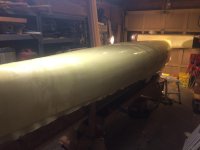Jim,
. Also it will allow me to build the hull with the ends closed as there will be no bond between strip hull and composite hull.
I'd recommend against that. BTDT and it didn't work very well.
For starters are you sure you can spread the hull wide enough to clear the tumblehome?
I built a composite tandem with no tumblehome using a woodstrip mold. I waxed the mold and applied PVA. I figured I'd be fine leaving the ends closed but at the late minute was convinced by other members to leave them open. I'm glad I did as it was a struggle getting it to release even with the open ends.
When it came time to close the ends I simply set the shell back on the form so that I could get the shape perfect. I put clear packing tape on the hull to keep anything from sticking and then peel ply over that so that, like you, I'd have a textured finish on the inside. Despite this I had a hell of a time getting the canoe to release. I honestly didn't think I'd get it off without ruining it for a while. I even pulled the first few forms out of the stripper hoping it would shrink a little. With those ends closed up there's absolutely no give at all, you can't get a run at it.
I finally got a thin piece of spring steel (for attaching large loads to pallets) slipped between the hulls so that it came out both sides about 1/4 of the way back along the hull. I clamped this to the strong back to hold the stripper in place as it kept trying to lift off the forms. Finally, after much hitting with a rubber mallet, prying and lifting the two separated.
I've heard that if you put a 50 cent piece in front of the wheels of a stopped train that it can't go forward without backing up first to get a little run at it. I don't know if that's true or not but that's how I envisioned those ends being stuck. The rest of the the hull is able flex but right there at the stems it's rigid and there's no give at all. So even though the bond is very low it won't budge.
I do like Jim's method of wrapping the stems during layup and then cutting a slit while the epoxy is still a little green so that they can be spread for release. Should make it easy to put them back together again later.
Alan


